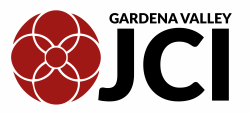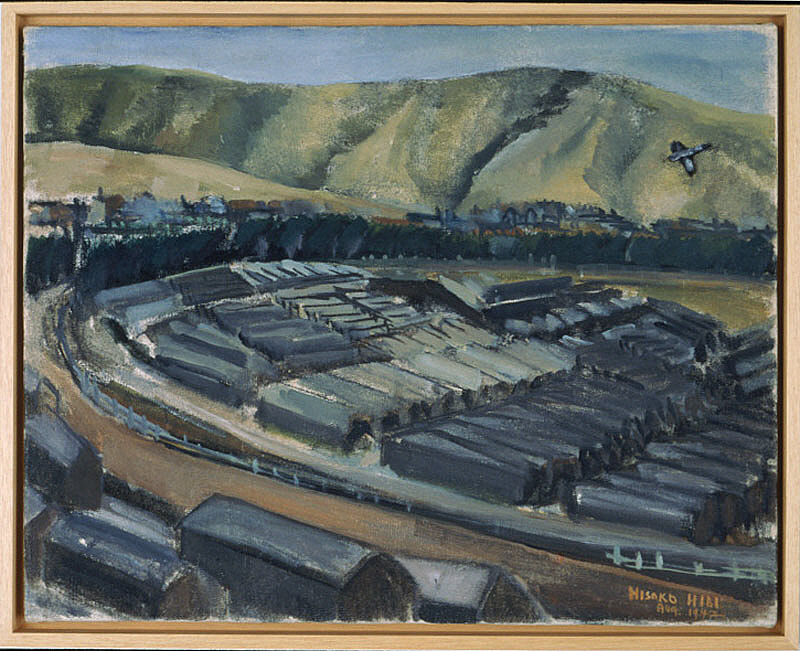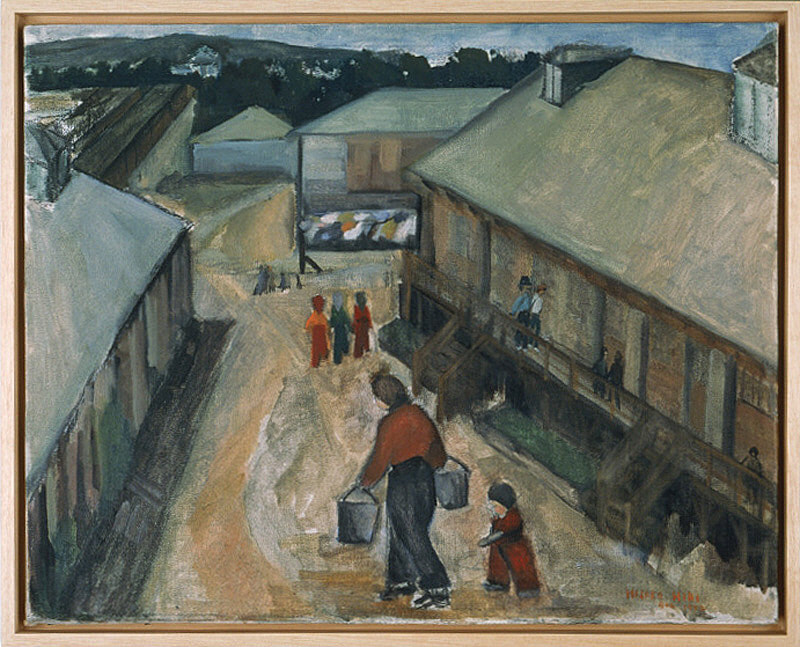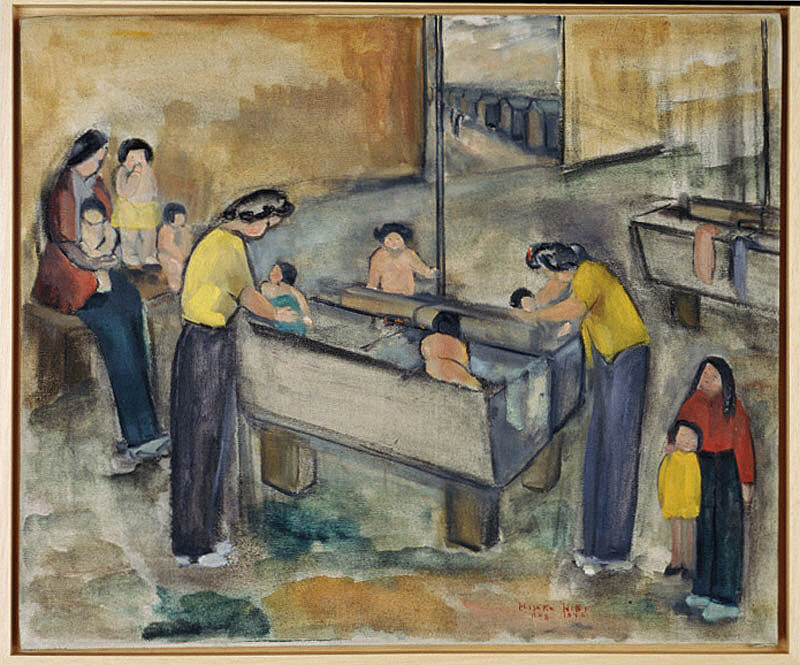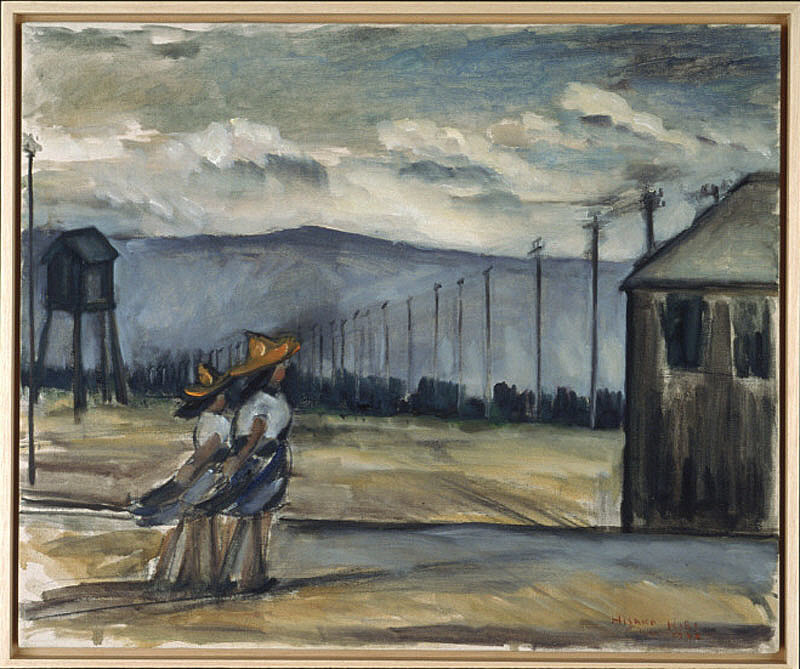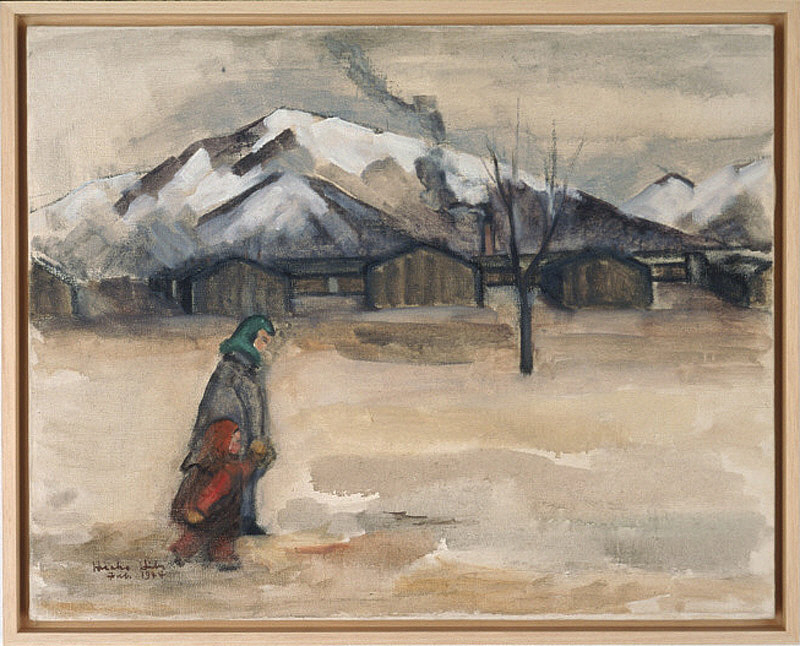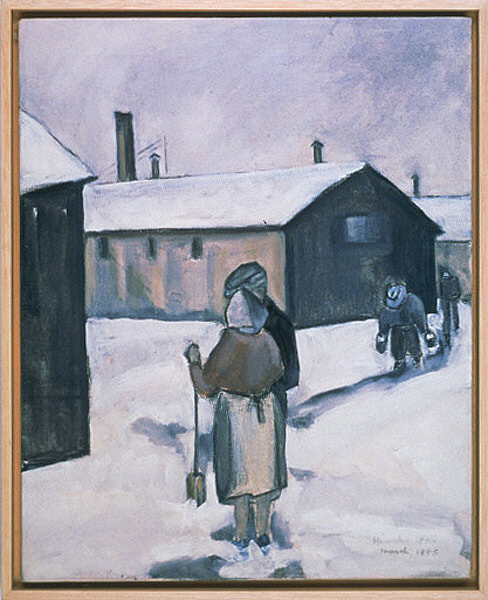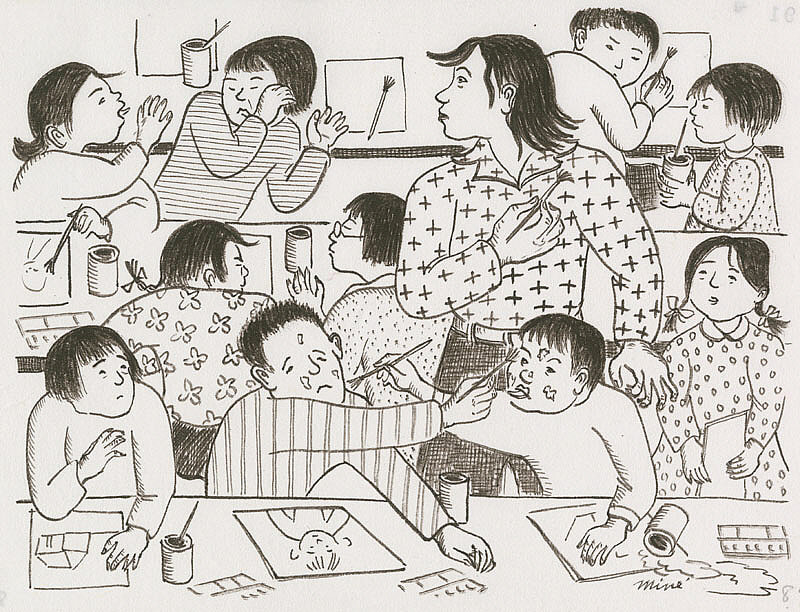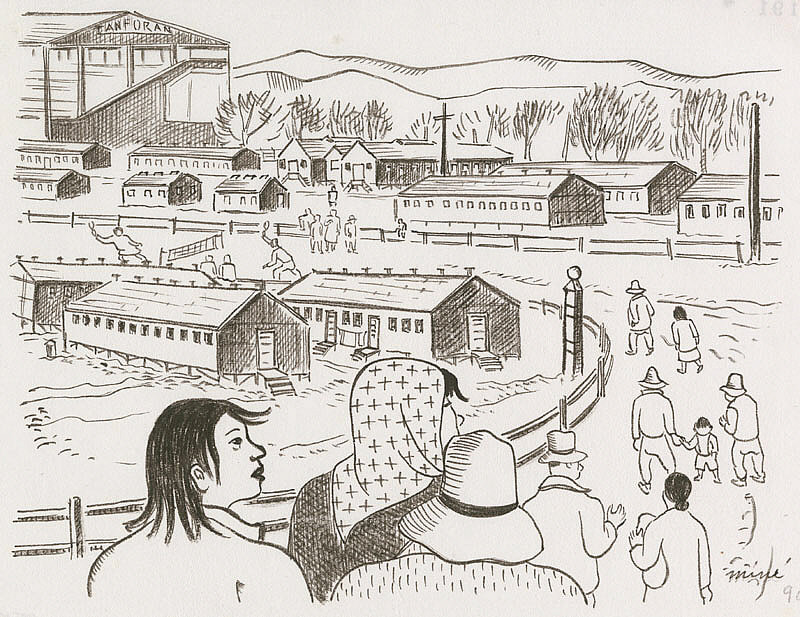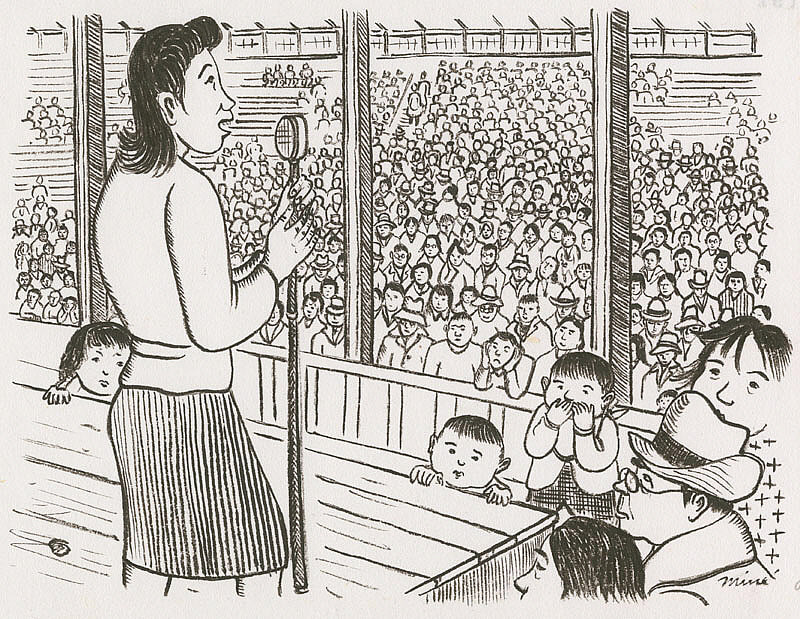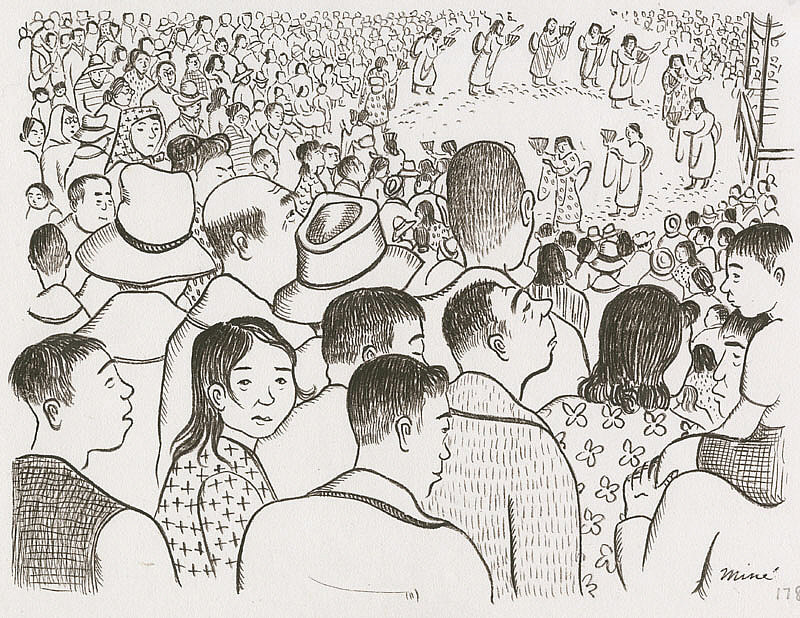FINE ART - TANFORAN-TOPAZ ART SCHOOL
GEORGE MATSUSABURO HIBI
Born: June 21 1886
Died: June 30 1947
Birth Location: Iimura, Japan
As the threat of war breaking out between Japan and the United States became unavoidable, Hibi donated fifty paintings to community venues in Hayward, stating "There is no boundary in art. This is the only way I can show my appreciation to my many American friends here."[2] Despite these efforts, very few prewar works exist. After Executive Order 9066 was signed by President Franklin D. Roosevelt in 1942, setting the mass incarceration of Japanese Americans off of the West Coast into motion, Hibi and his wife were moved to the Tanforan Assembly Center in San Bruno, California. Once the couple were settled, Hibi helped organize an art school in collaboration with artist Chiura Obata, structuring the curriculum on the mode of the California School of Fine Arts. After the Hibis were moved to a more permanent camp in Topaz, Utah, in 1942, a similar fine art school was set up for the incarcerees, offering instruction in sketching, watercolor, sumi-e, oil painting, and other technical workshops. The Topaz Art school also exhibited the work produced in camp. Some of Hibi's paintings and woodblock prints from the Topaz period, featuring the snowy barracks, desert landscapes and wolves circling the camp, are among his most well-known and respected. Following the medical release of Obata from Topaz in 1943, Hibi continued as the director of the art school for over two years.
Courtesy of Patricia Wakida, Densho
Born: June 21 1886
Died: June 30 1947
Birth Location: Iimura, Japan
As the threat of war breaking out between Japan and the United States became unavoidable, Hibi donated fifty paintings to community venues in Hayward, stating "There is no boundary in art. This is the only way I can show my appreciation to my many American friends here."[2] Despite these efforts, very few prewar works exist. After Executive Order 9066 was signed by President Franklin D. Roosevelt in 1942, setting the mass incarceration of Japanese Americans off of the West Coast into motion, Hibi and his wife were moved to the Tanforan Assembly Center in San Bruno, California. Once the couple were settled, Hibi helped organize an art school in collaboration with artist Chiura Obata, structuring the curriculum on the mode of the California School of Fine Arts. After the Hibis were moved to a more permanent camp in Topaz, Utah, in 1942, a similar fine art school was set up for the incarcerees, offering instruction in sketching, watercolor, sumi-e, oil painting, and other technical workshops. The Topaz Art school also exhibited the work produced in camp. Some of Hibi's paintings and woodblock prints from the Topaz period, featuring the snowy barracks, desert landscapes and wolves circling the camp, are among his most well-known and respected. Following the medical release of Obata from Topaz in 1943, Hibi continued as the director of the art school for over two years.
Courtesy of Patricia Wakida, Densho
HISAKO HIBI
Born: May 14 1907
Died: October 25 1991
Birth Location: Torihama, Japan
Hisako Shimizu Hibi (1907–91) was an Issei painter and printmaker who exhibited throughout her career, and by the end of her life she was well entrenched in the San Francisco Bay Area arts community. She was born on May 14, 1907, in Torihama, a farming village near Kyoto, Japan, and moved to San Francisco, California, in 1920. After graduating from Lowell High School, she decided to remain in San Francisco to pursue her art studies, although her parents returned to Japan in 1925. Hibi studied western-style oil painting at the California School of Fine Arts and participated in annual exhibitions at the San Francisco Art Association. While at the school, she met fellow student and painter George Matsusaburo Hibi, who was more than twenty years her senior, and the two were married in 1930.
Courtesy of Patricia Wakida, Densho
Born: May 14 1907
Died: October 25 1991
Birth Location: Torihama, Japan
Hisako Shimizu Hibi (1907–91) was an Issei painter and printmaker who exhibited throughout her career, and by the end of her life she was well entrenched in the San Francisco Bay Area arts community. She was born on May 14, 1907, in Torihama, a farming village near Kyoto, Japan, and moved to San Francisco, California, in 1920. After graduating from Lowell High School, she decided to remain in San Francisco to pursue her art studies, although her parents returned to Japan in 1925. Hibi studied western-style oil painting at the California School of Fine Arts and participated in annual exhibitions at the San Francisco Art Association. While at the school, she met fellow student and painter George Matsusaburo Hibi, who was more than twenty years her senior, and the two were married in 1930.
Courtesy of Patricia Wakida, Densho
Tanforan Assembly Center
Maker Hibi, Hisako
Date 1942
Medium oil, canvas
Dimensions H: 16 in, W: 20 in
Hibi, Hisako. “Tanforan Assembly Center.” 1942. “Hisako Hibi Collection”. Featured Collections. Museum Collection. Research & Collections. Japanese American National Museum. 19 Dec 2021, 22:10 PST
<https://janm.emuseum.com/objects/62481/tanforan-assembly-center?ctx=ec1a26953f1261e2acaffeb7ca956a7658b1c199&idx=0>
Maker Hibi, Hisako
Date 1942
Medium oil, canvas
Dimensions H: 16 in, W: 20 in
Hibi, Hisako. “Tanforan Assembly Center.” 1942. “Hisako Hibi Collection”. Featured Collections. Museum Collection. Research & Collections. Japanese American National Museum. 19 Dec 2021, 22:10 PST
<https://janm.emuseum.com/objects/62481/tanforan-assembly-center?ctx=ec1a26953f1261e2acaffeb7ca956a7658b1c199&idx=0>
A Few Renovated Horse Stables
Maker Hibi, Hisako
Date 1942
Medium oil, canvas
Dimensions H: 16 in, W: 20 in
Hibi, Hisako. “A Few Renovated Horse Stables.” 1942. “Hisako Hibi Collection”. Featured Collections. Museum Collection. Research & Collections. Japanese American National Museum. 19 Dec 2021, 23:05 PST
<https://janm.emuseum.com/objects/17530/a-few-renovated-horse-stables?ctx=ec1a26953f1261e2acaffeb7ca956a7658b1c199&idx=4>
Maker Hibi, Hisako
Date 1942
Medium oil, canvas
Dimensions H: 16 in, W: 20 in
Hibi, Hisako. “A Few Renovated Horse Stables.” 1942. “Hisako Hibi Collection”. Featured Collections. Museum Collection. Research & Collections. Japanese American National Museum. 19 Dec 2021, 23:05 PST
<https://janm.emuseum.com/objects/17530/a-few-renovated-horse-stables?ctx=ec1a26953f1261e2acaffeb7ca956a7658b1c199&idx=4>
Laundry Room
Maker Hibi, Hisako
Date 1942
Medium oil, canvas
Dimensions framed: H: 21 1/4 in, W: 25 1/4 in. Overall: H: 20 in, W: 24 in.
Hibi, Hisako. “Laundry Room.” 1942. “Hisako Hibi Collection”. Featured Collections. Museum Collection. Research & Collections. Japanese American National Museum. 19 Dec 2021, 23:09 PST
<https://janm.emuseum.com/objects/66824/laundry-room?ctx=3a750716bec412755ed6b760ac9b46c1796a3e1c&idx=14>
Maker Hibi, Hisako
Date 1942
Medium oil, canvas
Dimensions framed: H: 21 1/4 in, W: 25 1/4 in. Overall: H: 20 in, W: 24 in.
Hibi, Hisako. “Laundry Room.” 1942. “Hisako Hibi Collection”. Featured Collections. Museum Collection. Research & Collections. Japanese American National Museum. 19 Dec 2021, 23:09 PST
<https://janm.emuseum.com/objects/66824/laundry-room?ctx=3a750716bec412755ed6b760ac9b46c1796a3e1c&idx=14>
A Summer Day
Maker Hibi, Hisako
Date 1943
Medium oil, canvas
Dimensions H: 20 in, W: 24 in.
Hibi, Hisako. “A Summer Day.” 1943. “Hisako Hibi Collection”. Featured Collections. Museum Collection. Research & Collections. Japanese American National Museum. 19 Dec 2021, 23:26 PST
<https://janm.emuseum.com/objects/17992/a-summer-day?ctx=3a750716bec412755ed6b760ac9b46c1796a3e1c&idx=16>
Maker Hibi, Hisako
Date 1943
Medium oil, canvas
Dimensions H: 20 in, W: 24 in.
Hibi, Hisako. “A Summer Day.” 1943. “Hisako Hibi Collection”. Featured Collections. Museum Collection. Research & Collections. Japanese American National Museum. 19 Dec 2021, 23:26 PST
<https://janm.emuseum.com/objects/17992/a-summer-day?ctx=3a750716bec412755ed6b760ac9b46c1796a3e1c&idx=16>
With Mother
Maker Hibi, Hisako
Date 1944
Medium oil, canvas
Dimensions H: 16 in, W: 20 in.
Hibi, Hisako. “With Mother.” 1944. “Hisako Hibi Collection”. Featured Collections. Museum Collection. Research & Collections. Japanese American National Museum. 19 Dec 2021, 23:17 PST
<https://janm.emuseum.com/objects/16396/with-mother?ctx=a51e8e943d4cd412e28744e9cfc92adeb5255e44&idx=34>
Maker Hibi, Hisako
Date 1944
Medium oil, canvas
Dimensions H: 16 in, W: 20 in.
Hibi, Hisako. “With Mother.” 1944. “Hisako Hibi Collection”. Featured Collections. Museum Collection. Research & Collections. Japanese American National Museum. 19 Dec 2021, 23:17 PST
<https://janm.emuseum.com/objects/16396/with-mother?ctx=a51e8e943d4cd412e28744e9cfc92adeb5255e44&idx=34>
Conversation
Maker Hibi, Hisako
Date 1945
Medium oil, canvas
Dimensions H: 20 in, W: 16 in. Frame: H: 21 in, W: 17 in
Hibi, Hisako. “Conversation.” 1945. “Hisako Hibi Collection”. Featured Collections. Museum Collection. Research & Collections. Japanese American National Museum. 19 Dec 2021, 23:20 PST
<https://janm.emuseum.com/objects/22406/conversation?ctx=eba58254a89ea2a456962cdf333f3c5423ae8f9f&idx=44>
Maker Hibi, Hisako
Date 1945
Medium oil, canvas
Dimensions H: 20 in, W: 16 in. Frame: H: 21 in, W: 17 in
Hibi, Hisako. “Conversation.” 1945. “Hisako Hibi Collection”. Featured Collections. Museum Collection. Research & Collections. Japanese American National Museum. 19 Dec 2021, 23:20 PST
<https://janm.emuseum.com/objects/22406/conversation?ctx=eba58254a89ea2a456962cdf333f3c5423ae8f9f&idx=44>
CHIURA OBATA
Born: 1885
Died: 1975
Birth Location: Okayama, Japan
In Spring 1942, Obata and his family were removed from Berkeley under Executive Order 9066. He was forced to close his studio, and his artworks were stored by UC Berkeley president Robert Sproul. The Obatas (except for Gyo, who relocated to Washington University in St. Louis) were confined at Tanforan. There Obata and his friend George Matsusaburo volunteered to create an art school for inmates, which enrolled over 600 students. Miné Okubo served as one instructor. When the inmates were moved to the Topaz camp in Fall 1942, Obata and Hibi recreated the school there. In addition to teaching, Obata did hundreds of watercolors and sketches of the journey to camp and confinement experience. In addition to aesthetic value, these were designed to document the experience, since inmates were refused cameras. He also contributed drawings to the Topaz Times newspaper. Meanwhile, Obata did large-scale paintings of the desert landscape surrounding camp. In May 1943, representatives of the Japanese American Citizens League were received at the White House by First Lady Eleanor Roosevelt. They presented her with an Obata landscape, Moonlight Over Topaz, as a gift for the President.
Although Obata remained popular with his art students, his pro-American political stance alienated a faction of dissident inmates. In April 1943, a nighttime assault left Obata hospitalized. As a result, he received permission to leave camp, and resettled his family with his son Gyo in St. Louis, where he worked for a commercial art firm. Two years later, following the end of the war, the elder Obatas returned to Berkeley, where they were able to find a home and retrieve their artwork. Chiura Obata resumed his painting and teaching, and presented a show of his wartime art at UC Berkeley in 1946. In the following years, he participated in numerous shows. After his retirement from teaching in 1954, Obata led art tours of Japan. He published the instruction booklet Sumie (1967) and the guidebook Through Japan with Brush and Ink (1968).
Authored by Greg Robinson, Université du Québec À Montréal
Born: 1885
Died: 1975
Birth Location: Okayama, Japan
In Spring 1942, Obata and his family were removed from Berkeley under Executive Order 9066. He was forced to close his studio, and his artworks were stored by UC Berkeley president Robert Sproul. The Obatas (except for Gyo, who relocated to Washington University in St. Louis) were confined at Tanforan. There Obata and his friend George Matsusaburo volunteered to create an art school for inmates, which enrolled over 600 students. Miné Okubo served as one instructor. When the inmates were moved to the Topaz camp in Fall 1942, Obata and Hibi recreated the school there. In addition to teaching, Obata did hundreds of watercolors and sketches of the journey to camp and confinement experience. In addition to aesthetic value, these were designed to document the experience, since inmates were refused cameras. He also contributed drawings to the Topaz Times newspaper. Meanwhile, Obata did large-scale paintings of the desert landscape surrounding camp. In May 1943, representatives of the Japanese American Citizens League were received at the White House by First Lady Eleanor Roosevelt. They presented her with an Obata landscape, Moonlight Over Topaz, as a gift for the President.
Although Obata remained popular with his art students, his pro-American political stance alienated a faction of dissident inmates. In April 1943, a nighttime assault left Obata hospitalized. As a result, he received permission to leave camp, and resettled his family with his son Gyo in St. Louis, where he worked for a commercial art firm. Two years later, following the end of the war, the elder Obatas returned to Berkeley, where they were able to find a home and retrieve their artwork. Chiura Obata resumed his painting and teaching, and presented a show of his wartime art at UC Berkeley in 1946. In the following years, he participated in numerous shows. After his retirement from teaching in 1954, Obata led art tours of Japan. He published the instruction booklet Sumie (1967) and the guidebook Through Japan with Brush and Ink (1968).
Authored by Greg Robinson, Université du Québec À Montréal
MINE OKUBO
Born: June 27 1912
Died: February 10 2001
Birth Location: Riverside, California
Miné Okubo (1912-2001) remains best known as a narrator and artist of the Japanese American camp experience, most famously in her 1946 book Citizen 13660, a graphic memoir of her confinement at Tanforan and Topaz. However, Okubo considered herself first and foremost a painter, and she devoted seven decades to perfecting her art.
Early Life and Career
Miné Okubo was born in Riverside, California, on June 27, 1912, one of seven children of Tametsugu and Miyo (Kato) Okubo. According to family lore, Miyo Okubo had been an honors graduate of Tokyo Art Institute who was sent to the United States by the Japanese government to work as a calligrapher in the Japanese Arts and Crafts Show during the 1904 St. Louis World's Fair. Miné later recalled that her mother used to paint at home, and always encouraged her seven children to pursue artistic careers; Miné added nevertheless that her mother often lost patience with her early efforts at art because Miné could never copy anything precisely. After Miyo died in 1940, Miné paid tribute to her with the painting "Miyo and Cat," which portrayed her with Bible in hand. Another artistic influence was Miné's oldest brother Benji (Bunji) Okubo a pioneering Nisei painter and a director of the Art Students League in Los Angeles. Miné's older sister Yoshiko Okubo (Tanaka), an artist and gallery manager, was arguably the strongest influence on her developing career.
Courtesy of Patricia Wakida, Densho
Born: June 27 1912
Died: February 10 2001
Birth Location: Riverside, California
Miné Okubo (1912-2001) remains best known as a narrator and artist of the Japanese American camp experience, most famously in her 1946 book Citizen 13660, a graphic memoir of her confinement at Tanforan and Topaz. However, Okubo considered herself first and foremost a painter, and she devoted seven decades to perfecting her art.
Early Life and Career
Miné Okubo was born in Riverside, California, on June 27, 1912, one of seven children of Tametsugu and Miyo (Kato) Okubo. According to family lore, Miyo Okubo had been an honors graduate of Tokyo Art Institute who was sent to the United States by the Japanese government to work as a calligrapher in the Japanese Arts and Crafts Show during the 1904 St. Louis World's Fair. Miné later recalled that her mother used to paint at home, and always encouraged her seven children to pursue artistic careers; Miné added nevertheless that her mother often lost patience with her early efforts at art because Miné could never copy anything precisely. After Miyo died in 1940, Miné paid tribute to her with the painting "Miyo and Cat," which portrayed her with Bible in hand. Another artistic influence was Miné's oldest brother Benji (Bunji) Okubo a pioneering Nisei painter and a director of the Art Students League in Los Angeles. Miné's older sister Yoshiko Okubo (Tanaka), an artist and gallery manager, was arguably the strongest influence on her developing career.
Courtesy of Patricia Wakida, Densho
Evacuees Struggling Against Dust and Wind
Maker Okubo, Miné
Date 1942-1944
Medium paper, ink, mat board
Dimensions H: 9.25 in, W: 13 in
Okubo, Miné. “Evacuees Struggling Against Dust and Wind, Tanforan Assembly Center, San Bruno, California, 1942”. 1942-1944. “Miné Okubo Collection”. Featured Collections. Museum Collection. Research & Collections. Japanese American National Museum. 1 Jan 2022, 20:39 PST
<https://janm.emuseum.com/objects/56575/evacuees-struggling-against-dust-and-wind-tanforan-assembl?ctx=7b7e6001dc0f3cddced2b5b603a21a95c60ca80c&idx=24>
Maker Okubo, Miné
Date 1942-1944
Medium paper, ink, mat board
Dimensions H: 9.25 in, W: 13 in
Okubo, Miné. “Evacuees Struggling Against Dust and Wind, Tanforan Assembly Center, San Bruno, California, 1942”. 1942-1944. “Miné Okubo Collection”. Featured Collections. Museum Collection. Research & Collections. Japanese American National Museum. 1 Jan 2022, 20:39 PST
<https://janm.emuseum.com/objects/56575/evacuees-struggling-against-dust-and-wind-tanforan-assembl?ctx=7b7e6001dc0f3cddced2b5b603a21a95c60ca80c&idx=24>
Reading, Sleeping and Practicing Music in Bachelor’s Dorm
Maker Okubo, Miné
Date 1942-1944
Medium paper, ink, mat board
Dimensions H: 9.25 in, W: 13 in
Okubo, Miné. “Reading, Sleeping and Practicing Music in Bachelor’s Dorm, Tanforan Assembly Center, San Bruno, California, 1942”. 1942-44. “Miné Okubo Collection”. Featured Collections. Museum Collection. Research & Collections. Japanese American National Museum. 3 Dec 2021, 20:01 PST
<https://janm.emuseum.com/objects/53932/reading-sleepinig-and-practicing-music-in-bachelors-dorm?ctx=3b17c09646de2445019e89b081bc1e5e3ec6930d&idx=51>
Maker Okubo, Miné
Date 1942-1944
Medium paper, ink, mat board
Dimensions H: 9.25 in, W: 13 in
Okubo, Miné. “Reading, Sleeping and Practicing Music in Bachelor’s Dorm, Tanforan Assembly Center, San Bruno, California, 1942”. 1942-44. “Miné Okubo Collection”. Featured Collections. Museum Collection. Research & Collections. Japanese American National Museum. 3 Dec 2021, 20:01 PST
<https://janm.emuseum.com/objects/53932/reading-sleepinig-and-practicing-music-in-bachelors-dorm?ctx=3b17c09646de2445019e89b081bc1e5e3ec6930d&idx=51>
Teaching Art Classes
Maker Okubo, Miné
Date 1942-1944
Medium paper, ink
Dimensions H: 9.25 in, W: 13 in
Okubo, Miné. “Teaching Art Classes, Tanforan Assembly Center, San Bruno, California, 1942”. 1942-1944. “Miné Okubo Collection”. Featured Collections. Museum Collection. Research & Collections. Japanese American National Museum. 1 Jan 2022, 22:02 PST
<https://janm.emuseum.com/objects/52773/teaching-art-classes-tanforan-assembly-center-san-bruno?ctx=3e5fa51bba5ec8cdf0c84212d1fcb436d26416ca&idx=155>
Maker Okubo, Miné
Date 1942-1944
Medium paper, ink
Dimensions H: 9.25 in, W: 13 in
Okubo, Miné. “Teaching Art Classes, Tanforan Assembly Center, San Bruno, California, 1942”. 1942-1944. “Miné Okubo Collection”. Featured Collections. Museum Collection. Research & Collections. Japanese American National Museum. 1 Jan 2022, 22:02 PST
<https://janm.emuseum.com/objects/52773/teaching-art-classes-tanforan-assembly-center-san-bruno?ctx=3e5fa51bba5ec8cdf0c84212d1fcb436d26416ca&idx=155>
Strolling Around the Racetrack
Maker Okubo, Miné
Date 1942-1944
Medium paper, ink
Dimensions H: 9.25 in, W: 13 in
Okubo, Miné. “Strolling around the racetrack, Tanforan Assembly Center, San Bruno, California, 1942”. 1942-1944. “Miné Okubo Collection”. Featured Collections. Museum Collection. Research & Collections. Japanese American National Museum. 3 Dec 2021, 21:40 PST
<https://janm.emuseum.com/objects/59732/strolling-around-the-racetrack-tanforan-assembly-center-s?ctx=cdc5842c930265c5ec303f7b79aae129bf2184c4&idx=27>
Maker Okubo, Miné
Date 1942-1944
Medium paper, ink
Dimensions H: 9.25 in, W: 13 in
Okubo, Miné. “Strolling around the racetrack, Tanforan Assembly Center, San Bruno, California, 1942”. 1942-1944. “Miné Okubo Collection”. Featured Collections. Museum Collection. Research & Collections. Japanese American National Museum. 3 Dec 2021, 21:40 PST
<https://janm.emuseum.com/objects/59732/strolling-around-the-racetrack-tanforan-assembly-center-s?ctx=cdc5842c930265c5ec303f7b79aae129bf2184c4&idx=27>
Talent Show at the Grandstand
Maker Okubo, Miné
Date 1942-1944
Medium paper, ink
Dimensions H: 9.75 in, W: 14.5 in
Okubo, Miné. “Talent Show at the Grandstand, Tanforan Assembly Center, San Bruno, California, 1942”. 1942-1944. “Miné Okubo Collection”. Featured Collections. Museum Collection. Research & Collections. Japanese American National Museum. 1 Jan 2022, 21:53 PST
<https://janm.emuseum.com/objects/52775/talent-show-at-the-grandstand-tanforan-assembly-center-sa?ctx=3e5fa51bba5ec8cdf0c84212d1fcb436d26416ca&idx=150>
Maker Okubo, Miné
Date 1942-1944
Medium paper, ink
Dimensions H: 9.75 in, W: 14.5 in
Okubo, Miné. “Talent Show at the Grandstand, Tanforan Assembly Center, San Bruno, California, 1942”. 1942-1944. “Miné Okubo Collection”. Featured Collections. Museum Collection. Research & Collections. Japanese American National Museum. 1 Jan 2022, 21:53 PST
<https://janm.emuseum.com/objects/52775/talent-show-at-the-grandstand-tanforan-assembly-center-sa?ctx=3e5fa51bba5ec8cdf0c84212d1fcb436d26416ca&idx=150>
Hanamatsuri (Flower Festival)
Maker Okubo, Miné
Date 1942-1944
Medium paper, ink
Dimensions H: 9.75 in, W: 14.5 in
Okubo, Miné. “Hanamatsuri (Flower Festival), Central Utah Relocation Project, Topaz, Utah, 1942-1944”. 1942-1944. “Miné Okubo Collection”. Featured Collections. Museum Collection. Research & Collections. Japanese American National Museum. 20 Dec 2021, 21:36 PST
<https://janm.emuseum.com/objects/56758/hanamatsuri-flower-festival-central-utah-relocation-proj?ctx=068e0943f36a511fbece3d9d4ad656d41373e4c3&idx=16>
Maker Okubo, Miné
Date 1942-1944
Medium paper, ink
Dimensions H: 9.75 in, W: 14.5 in
Okubo, Miné. “Hanamatsuri (Flower Festival), Central Utah Relocation Project, Topaz, Utah, 1942-1944”. 1942-1944. “Miné Okubo Collection”. Featured Collections. Museum Collection. Research & Collections. Japanese American National Museum. 20 Dec 2021, 21:36 PST
<https://janm.emuseum.com/objects/56758/hanamatsuri-flower-festival-central-utah-relocation-proj?ctx=068e0943f36a511fbece3d9d4ad656d41373e4c3&idx=16>
Special thanks to:
Clement Hanami, Japanese American National Museum
Patricia Wakida, Densho
Alvin Takamori, GVJCI Day of Remembrance committee member
Clement Hanami, Japanese American National Museum
Patricia Wakida, Densho
Alvin Takamori, GVJCI Day of Remembrance committee member
